Is Ronda Worth Visiting? Of course, Ronda is worth visiting. The various types of colorful places, picturesque streets, and impressive historical landmarks will blow your mind. You can keep it in your next travel destination bucket easily.
This post will showcase the topmost things to do in Ronda which will you give a clear idea if it’s worth your time or not.
In this post, we will discuss the top places to visit, things to do, and whether Ronda is worth visiting and seeing or not.
This list of the best places to see in Ronda will help you organize a day trip to one of Spain’s most beautifully historic cities, Spain. This will optimize time to the maximum.
Situated on the top of a plateau carved by an imposing gorge over 150 meters high and surrounded by the stunning environment of the Serrania de Ronda.
It is known as the dream city of Andalusia because of its ancient history and extensive architectural and cultural heritage.
The best time to visit the beautiful historic center of Ronda, the third most visited municipality in Andalusia, is from October to March.
However, the presence of tourists is maintained throughout the year. Therefore, it is highly advisable to spend a night in the city and take advantage of the early morning and late afternoon. These are the quietest times of the day.
Having spent a substantial amount of time in this city during our route through the province of Malaga by car and being one of the most beautiful places to visit in Andalusia , we have compiled a list of the top 25 best things to do in Ronda. Let’s start!
, we have compiled a list of the top 25 best things to do in Ronda. Let’s start!
People Also Read: What Are The Best Free Tours In Ronda, Spain Where To Eat In Ronda The 9 Best Restaurants To Taste Local Cuisine In Ronda
Page Contents
Is Ronda Spain Worth Visiting? 25 Best Places To Visit in Ronda, Spain
1. Enjoy nature in the Natural Parks of Serranía de Ronda
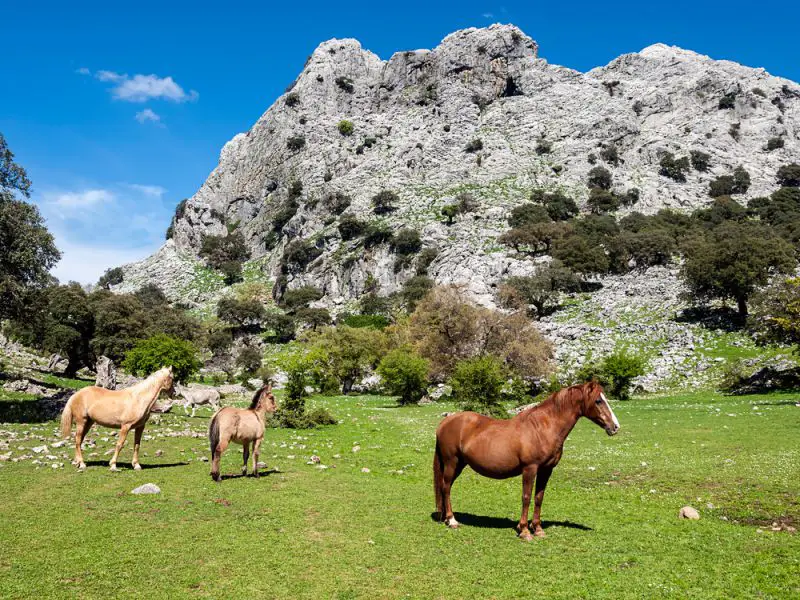
If you have time during your visit, you should know that natural parks surround Ronda in the area known as Serrania de Ronda. If you like nature, here are some recommendations for you to enjoy:
Los Alcornocales Natural Park: Be careful because you are not in front of just any nature reserve, but the last redoubt of Selva in Europe!
Long ago, in the tertiary era, the warm and tropical climate of the area led to the creation of rainforests in the Mediterranean.
However, with the change in environment, these forests have been disappearing little by little, except for Los Alcornocales, which still considers itself a jungle because of its unique climatic conditions.
Sierra de Grazalema: If Los Alcornocales surprised you, the Sierra de Grazalema would not disappoint.
At an altitude of 1500 meters and facing the Atlantic, this mountain range is the place where it rains the most in Spain.
Sierra de las Nieves Natural Park: Last but not least, and surprisingly, we find the Sierra de las, Nieves.
This mountain range, full of pinsapos, a kind of endemic fir tree that you will only find in the Serranía de Ronda, hides another great secret.
The Sierra de las Nieves is one of the deepest caves in the world, with more than 1200 meters of unevenness.
2. Stroll around the Plaza del Socorro and the surrounding area.
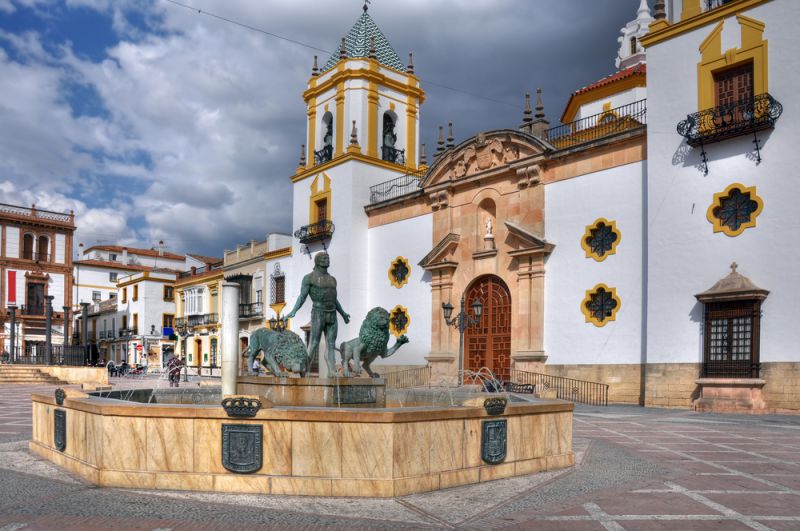
The Plaza Socorro is one of the busiest places in Ronda and an obligatory stop when you feel like having a good snack. In addition to having several terraces, you will find there the Socorro Church.
You can’t miss the Duquesa de Parcent square where the Santa María la Mayor church is located. I love this square. Also very close to here is the Palace of Mondragon, there is the Municipal Museum of Ronda. One of the free things to do in Ronda.
People Also Read: Where To Eat In Ronda? The 9 Best Restaurants To Taste Local Cuisine In Ronda
3. New Bridge – One of the top places to see in Ronda

The New Bridge is, without a doubt, the main protagonist of the city. It is not particularly long, nor ancient.
However, its location, saving the gorge of the Tajo de Ronda at 100 meters high, connecting one part of the city to the other, makes it unique. It was completed in 1793 and since then is the emblem of Ronda.
There are several viewpoints from which to appreciate its true magnitude, and these are the most famous:
Viewpoint in front of the New Bridge, accessed from the Plaza de Maria Auxiliadora through a flight of stairs, is ideal for watching the sunset. You can continue towards the bridge along a path on the slope of the rock itself, not suitable for those who suffer from vertigo.
Viewpoint on the Carretera de los Molinos is located outside the village, down a cobblestone slope. From here, you can walk up to the Arco del Cristo, one of the ancient entrances in the Arab wall. It is advisable to go by car, but be careful with the climb on the way back.
Viewpoint of Aldehuela, in the same town, next to the Palacio de Congresos.
4. Old Bridge
It is not the only symbolic bridge, the other one that deserves a visit is the Old Bridge, built by the Arabs in the 15th century (although some say it dates back to Roman times).
There are other exciting places in this area, such as the remains of the Arab Baths (3€ entrance fee), the Arab Bridge, or the small Hermitage of San Miguel.
5. Church of the Holy Spirit
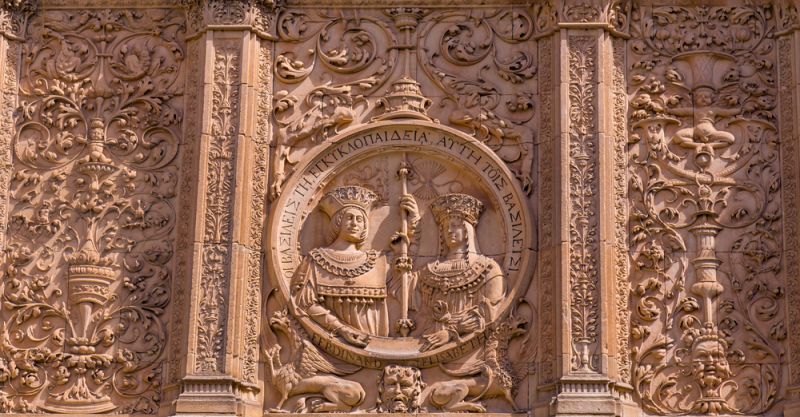
Behind it, in the background, stand the walls and roofs of the Church of the Holy Spirit, which looks more like a fortification built by order of the Catholic Monarchs themselves on an ancient mosque of the city.
People Also Read: What Are The Best Free Tours In Ronda, Spain?
6. Church of Santa María la Mayor – Another must-see in Ronda.
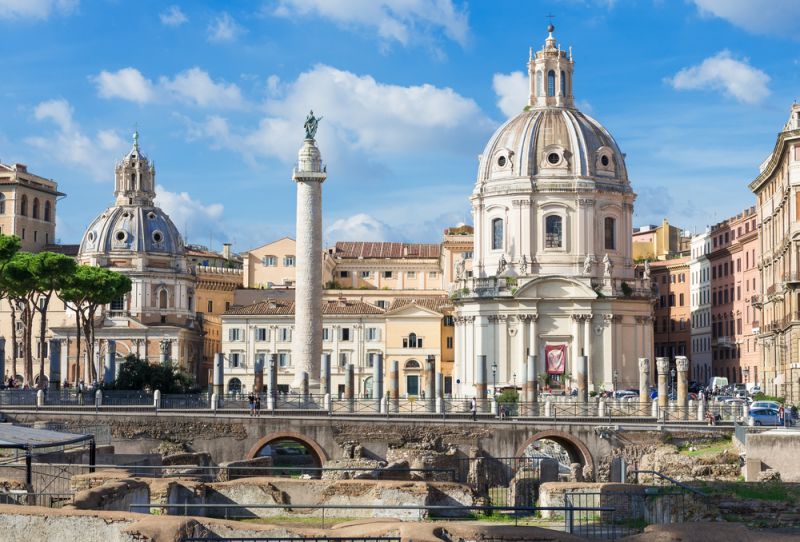
The most prominent church of Ronda, Santa Maria la Mayor, is from the same period as the mosque and shares its history.
Inside the church, the mihrab arch and a decorated section of the wall are remnants of its ancient Muslim past. On the outside, the octagonal bell tower crowned by a series of pointed pinnacles stands out.
The entrance with an audio guide costs €4.50. It is undoubtedly one of the best things to see and do in Ronda.
7. Ronda is worth visiting if you like – Minaret of San Sebastian
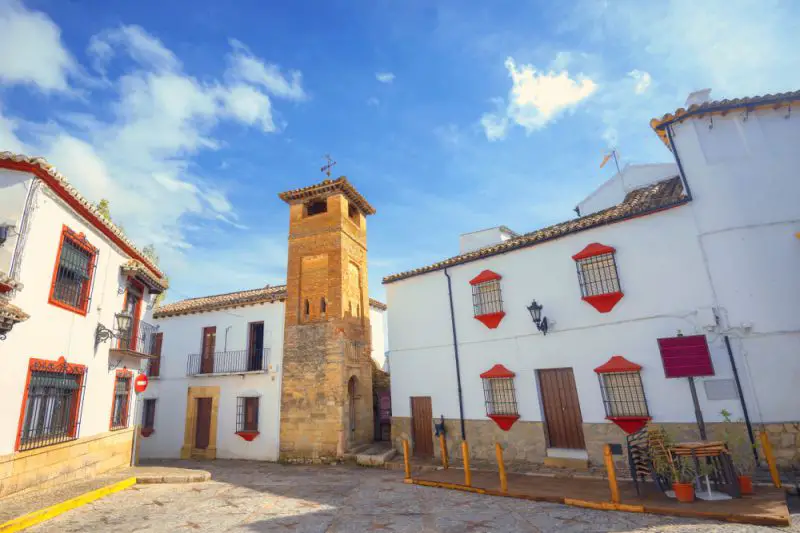
Another trace of Ronda’s Muslim past is the Alminar de San Sebastián. It was once the tower of an old mosque, with a beautiful entrance arch made of stone and brick, which stands out among so many white houses in the heart of the old town.
The small square where it is located is called “Abul Beka,” in honor of the Arab poet born in Ronda. Visiting Minaret of San Sebastian is one of the free things to do in Ronda, Spain.
8. Bullring of Ronda
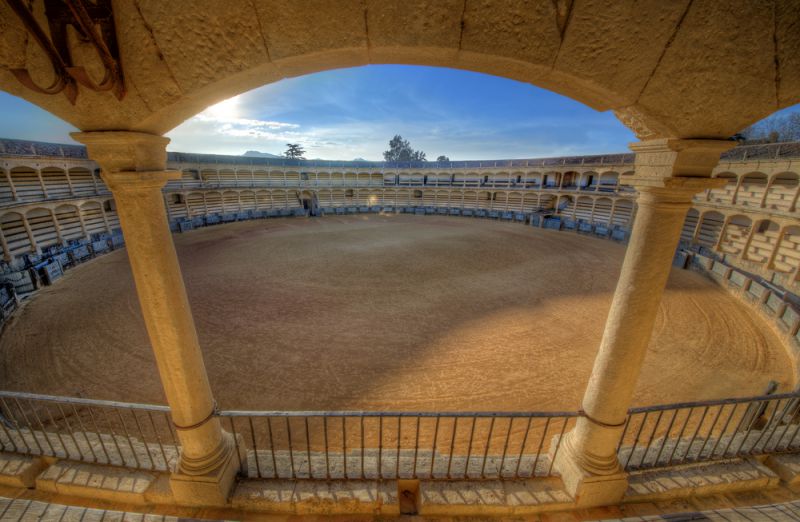
The Plaza de Toros de la Real Maestranza de Caballería was inaugurated in 1785 and is therefore one of the oldest bullrings in Spain.
Although we are not very much into bullfighting, this is one of the most emblematic places in Ronda.
This is where the “corrida goyesca” was popularized, in which the bullfighting costumes were replaced by other typical costumes of the eighteenth century. Currently, only one event is held each year: the Feria Goyesca (in September).
9. Paseo de Blas Infante – A must visit place in Ronda
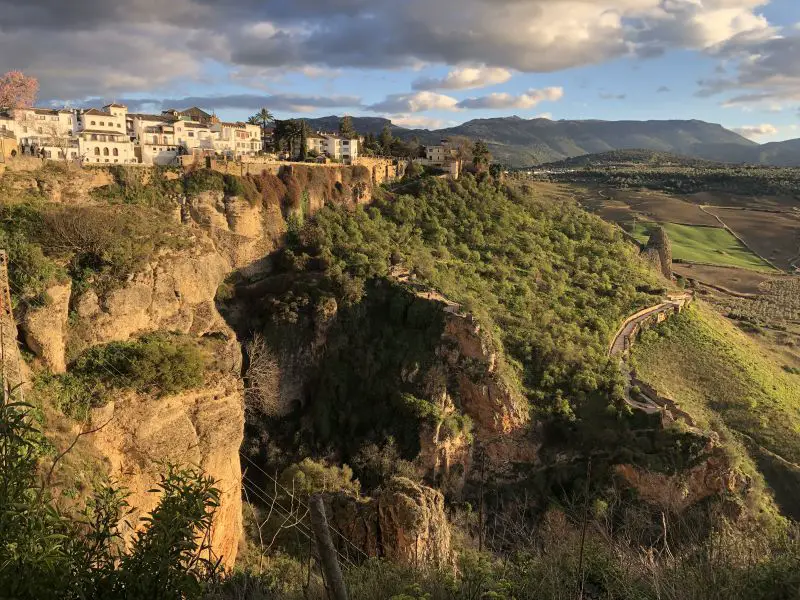
Nearby two statues have been placed in tribute to two of its most famous fans: Orson Welles and Ernest Hemingway. And behind them stretches the Paseo de Blas Infante, where one of Ronda’s many viewpoints is located.
10. Alameda del Tajo: Free things to do in Ronda, Spain
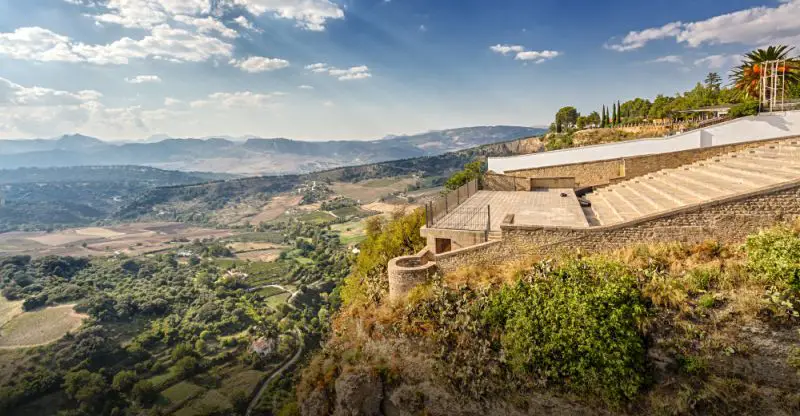
Although you are looking for a place to relax in the shade of the trees, there is nothing better than the Alameda del Tajo, Ronda’s little green lung.
It is right on the ravine, so the views from its huge balcony are breathtaking. And if you feel like a “high altitude walk,” continue along the Paseo De Los Ingleses that starts from here and skirts the cliff.
11. Palacio de Mondragón
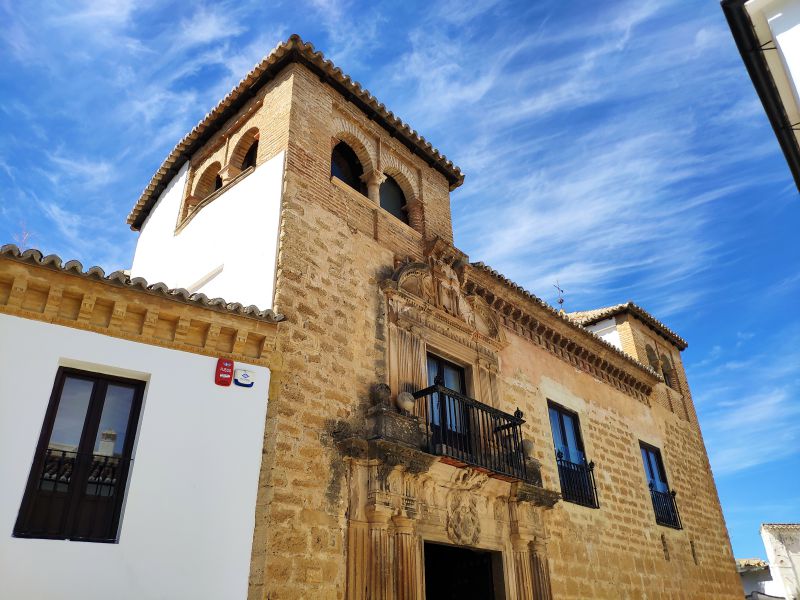
There is one building that exudes history more than any other: the Palacio de Mondragón. It was the residence of King Abbel Malik and the Nasrid governors in the first place, and after the reconquest, the home of the Catholic Monarchs themselves during their stay in Ronda.
It currently houses the Municipal Museum, and although its exhibits are not particularly striking, the building itself is worth a visit (entrance fee: 3.50€).
12. Bandolero Museum
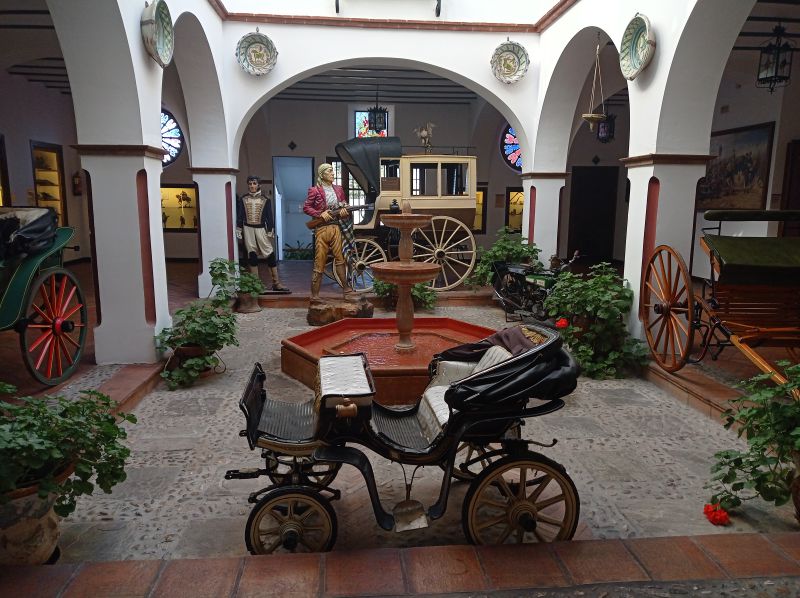
The Bandolero Museum is the only one in Spain with this theme and collects many objects about the tradition of bandits in Andalusia (does Curro Jimenez ring a bell?). It is a curious thing to do in Ronda.
13. Plaque of the Romantic Travelers
Before leaving Ronda, you should have your picture taken in front of the plaque of the Romantic Travelers, a beautiful tile mural depicting the city and two lovers on either side.
14. Wineries of the Serrania de Ronda
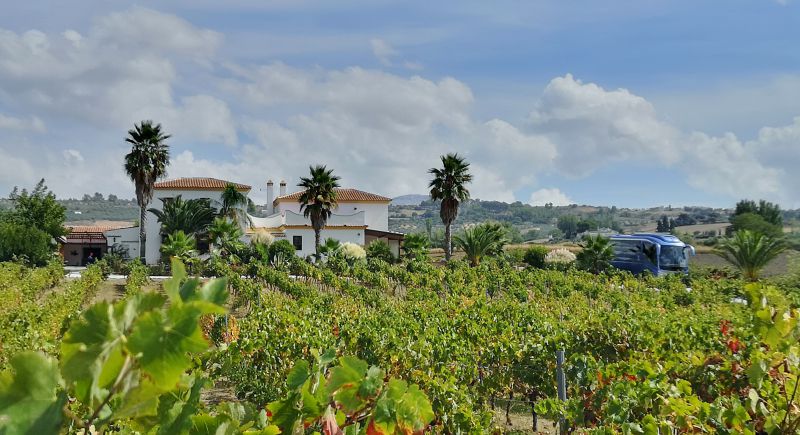
The Serrania de Ronda has a winemaking tradition that dates back to Roman times.
You can experience these flavors by visiting one of its wineries, where grapes grow that make wines of origin.
Examples, the García Hidalgo Winery (10km away), the Joaquín Fernández Winery (13km away) and the Doña Felisa Winery (18km away).
15. Ruins of Acinipo
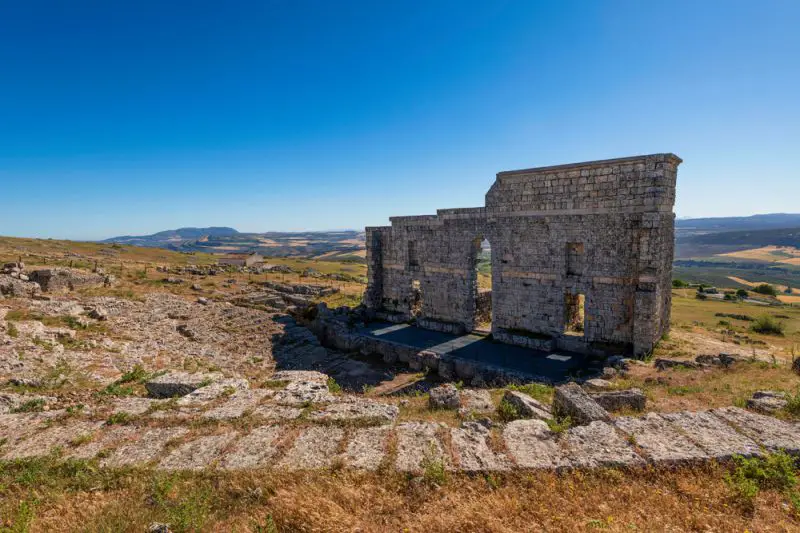
Finally, take a trip back in time to the ruins of Acinipo, an ancient Roman city 18 km from Ronda, where you can admire its theater, one of the oldest (dating from the first century BC) and best preserved in Spain. As the admission is free which makes it another of the free thing to do in Ronda.
16. Duquesa de Parcent Square
One of the best ways to see Ronda in one day is to leave the car in the parking lot of Plaza de la Duquesa de Parcent and start the city tour from here.
In this landscaped and large space, which occupies the place of the old Plaza Mayor of the Muslim Medina, are some of the most important buildings of the old town like the City Hall (former barracks of Provincial Militias), the Convent of Charity, the Convent of Poor Clares of Santa Isabel de los Angeles, the Church of Maria Auxiliadora and El Castillo, a school located in the citadel of the city.
Although for us the most interesting building is the church of Santa Maria la Mayor. This church was elevated to a collegiate church by King Ferdinand the Catholic. The building was built on top of the city’s old mosque, which still has parts of its mihrab intact.
In addition to these remains and its past, this temple harmoniously combines Renaissance, Gothic and Baroque styles that can be seen in elements such as the two-story choir, the columns, and the facade, which stands out for its original three-story gallery and a high brick tower.
17. Almocabar Gate
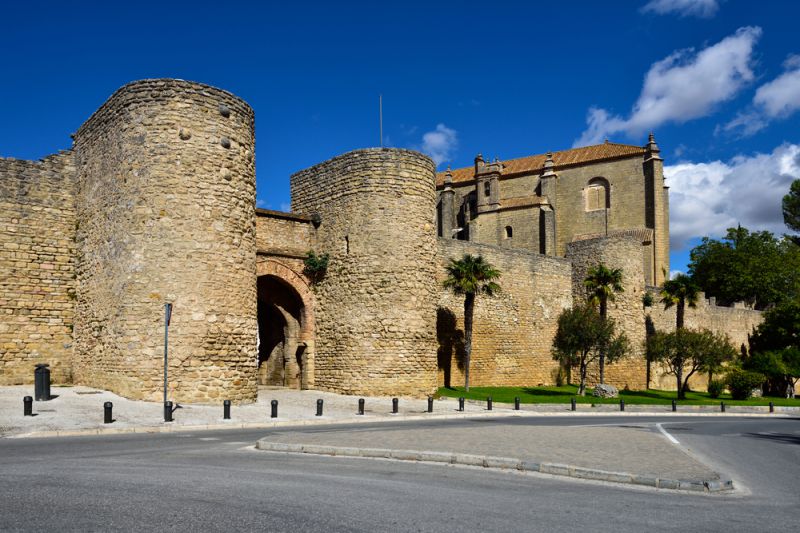
Walking down the busy Calle Armiñán, you will reach the Almocábar Gate, the main entrance to the city in the Muslim era and another of the most beautiful places to see in Ronda.
This monumental entrance, the largest in the city, consisting of three gates and two semicircular towers, was built by the Arabs in the thirteenth century and modified in the time of Emperor Charles V.
Once you cross the gate, you will find a charming square with several fantastic restaurants, among which are the delicious bites of De Locos Tapas. It is a highly recommended restaurant in Ronda.
However, if you prefer more traditional food, you can cross the gate again and go to Casa Maria, another must.
Another place you should not miss is the Church of the Holy Spirit, built on the site of an ancient Muslim mosque by order of the Catholic monarchs in the fifteenth century.
18. New Bridge of Ronda

The next stop on the route is the viewpoint of La Hoya del Tajo. This viewpoint has fantastic views of the New Bridge, the most emblematic place to visit in Ronda.
Built between 1751 and 1793, this bridge, which was the highest in the world until 1839, allows you to cross the gorge of the Tajo de Ronda, more than 100 meters high, excavated for centuries by the Guadalevín river and linking the old quarter with the new quarter (Mercadillo).
After enjoying the views from the lowest point, you can go up to the Mirador del Puente Nuevo, our favorite, having a complete perspective with the bridge, the waterfall, and the river flowing below, in the same plane.
From this viewpoint, a dirt path will take you even closer to the gorge, leaving you with other breathtaking views.
To finish, you can go up some stairs to the Plaza María Auxiliadora, which has another spectacular viewpoint.
19. Casa de Juan Bosco – One of the places to see in Ronda in one day.
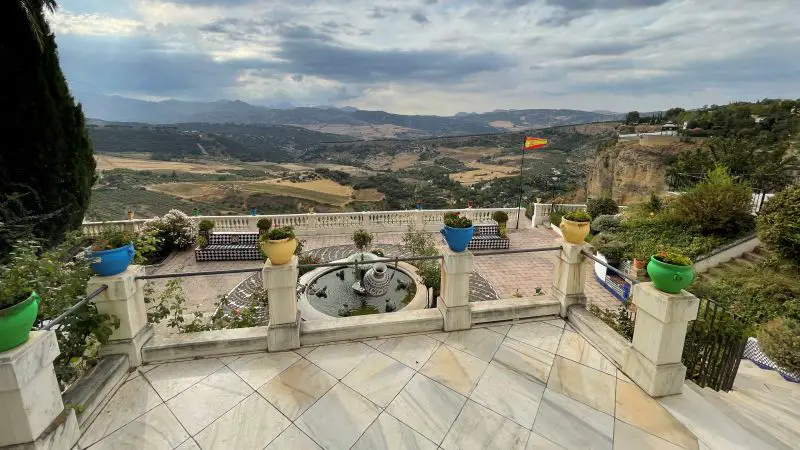
A few meters from the Plaza María Auxiliadora are the Palacio de Mondragón and the Casa de Juan Bosco, two of the most significant historical buildings in Ronda.
The Casa de Juan Bosco, a modernist mansion built in the early twentieth century and located on the edge of the Tagus, stands out for its beautiful gardens overlooking the New Bridge and decorated with Nasrid tiles, plus a valuable collection of ceramics and an item of furniture made of walnut wood.
Meanwhile, the Mondragon Palace is a building that blends Mudejar and Renaissance architecture and was the former residence of the Benimerí King Abd al-Malik, son of a Moroccan sultan.
Before becoming the residence of the Catholic Monarchs, after the reconquest of Ronda, today, this palace, with three beautiful interior courtyards, houses the Municipal Museum of Ronda, which exhibits a collection of the city’s history and the region.
Visiting hours Casa de Juan Bosco: every day from 9:30h to 17:30h (in summer, it closes at 19h).
Visiting hours Municipal Museum: Monday to Friday from 10 am to 6 pm (closes at 7 pm in summer); weekends from 10 am to 3 pm.
20. Promenade of the English
Another of the best things to do in Ronda is a walk from the Casa de Juan Bosco to the Alameda del Tajo. This walk passes by the beautiful mural of the Romantic Travelers.
It also stops at the viewpoint of the Aldehuela, which has fantastic views of the New Bridge.
Once you cross the bridge, you will arrive at the Plaza España, from where you can walk along the beautiful Paseo de los Ingleses, which runs along a cliff over 100 meters high.
During the tour, you will enjoy incredible views of the entire natural environment surrounding the city, especially from the Mirador de Ronda, located on a ledge of the cliff.
From this viewpoint, you can continue the route through the essential places to see in Ronda, passing in front of the Plaza de Toros, one of the oldest in the country.
At the Alameda del Tajo, the busts of Orson Welles and Ernest Hemingway, two lovers of this city, stand out.
21. Neighborhood of Padre Jesus
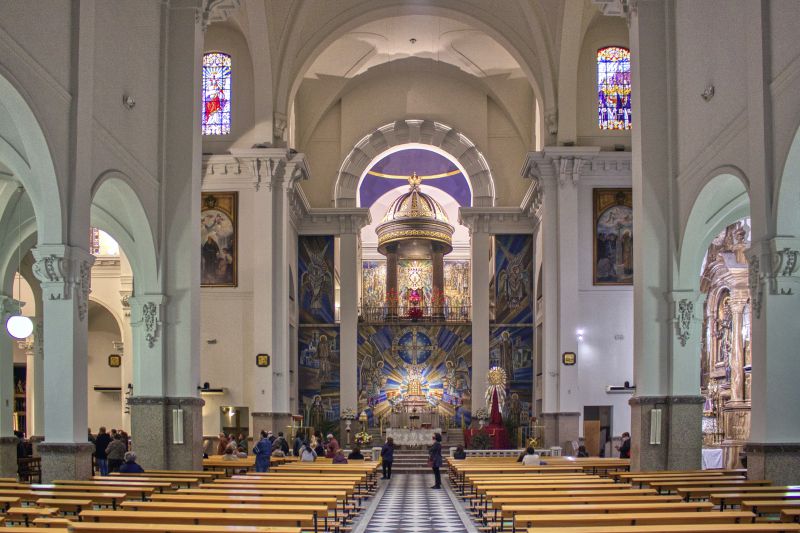
From the Alameda del Tajo, you can approach the Barrio del Padre Jesus to see the Plaza del Socorro and the Fuente de los Ocho Caños, two of the most beautiful places to visit in Ronda.
The emblematic and pedestrian Plaza del Socorro houses the Church of Socorro, the old Casino, the fountain of Hercules, and a sculpture of Blas Infante, considered the father of the Andalusian homeland.
You can walk down Calle Virgen de los Remedios to the Church of Padre Jesus, where one of Ronda’s most revered images awaits procession on Holy Thursday, as well as the iconic Fuente de los Ocho Canos. The neighborhood of Padre Jesus is among the best things to see in Ronda.
22. Gardens of Cuenca de Ronda
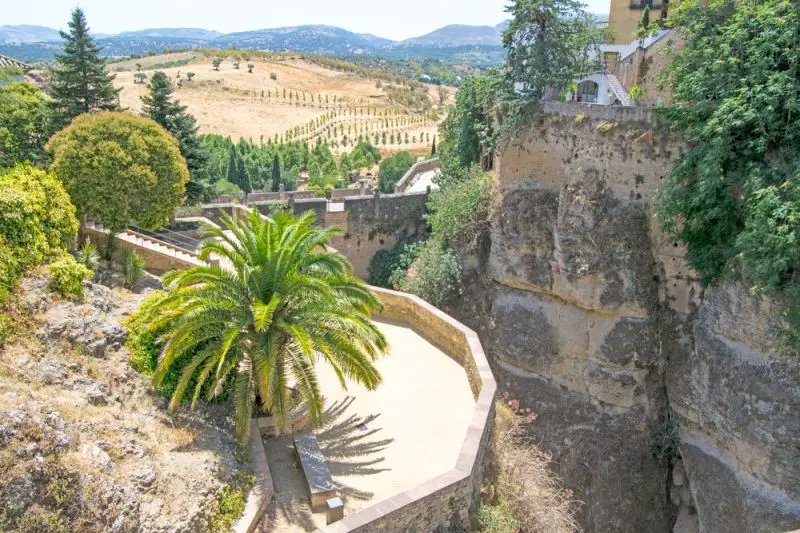
Another of the most aesthetic places to see in Ronda are the Jardines de Cuenca, a set of viewpoints located in staggered terraces on the cornice of the Tajo de Ronda, between the New Bridge and the Old Bridge.
In these gardens, the product of the twinning with the Spanish city of Cuenca, you can find native flora such as the Andalusian prickly pears to incredible views of the gorge, and the buildings located on the ledge opposite, such as the Casa del Rey Moro (House of the Moorish King).
23. Visit the House of the Moorish King – Another of the things to do in Ronda
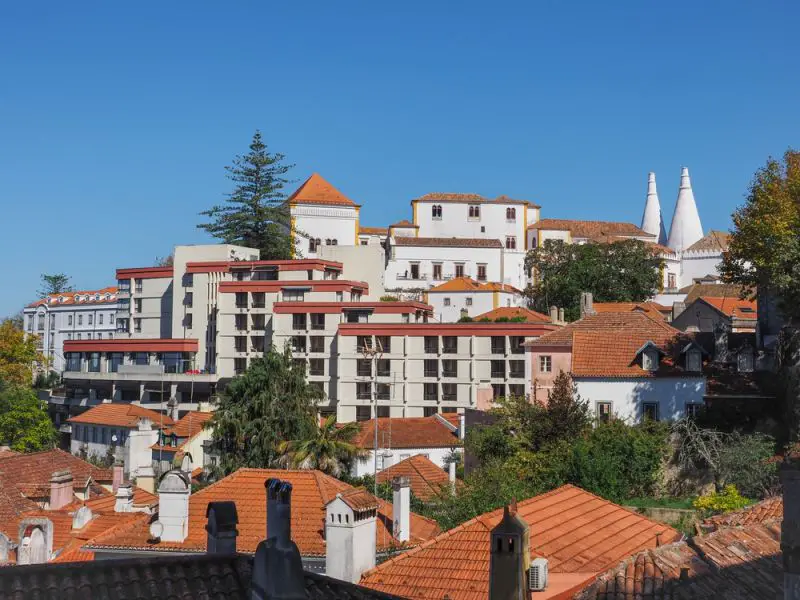
Visiting the house of the Moorish king is one of the top things to do in Ronda. Once you cross the Old Bridge, of Arab origin, and go up a slight stretch of the Cuesta de Santo Domingo, we recommend entering the House of the Moorish King.
In one of the palace’s rooms, a large waterwheel supplied water to the entire city in case of siege through a water mine built by Arabs in the 14th century.
The Christians, aware of this weakness, focused their attacks on the waterwheel, causing the city’s surrender in a few days. This turned this palace into a key place in the history of the reconquest.
We recommend you to walk through its beautiful gardens and observe from the outside the Neomudejar style house, designed by the Duchess of Parcent after you visit Parkent Palace.
Additionally, you can explore the interior of this impressive engineering work until you reach the Guadalevin River.
Visiting hours: every day from 10 am to 9:30 pm.
24. Arab Baths
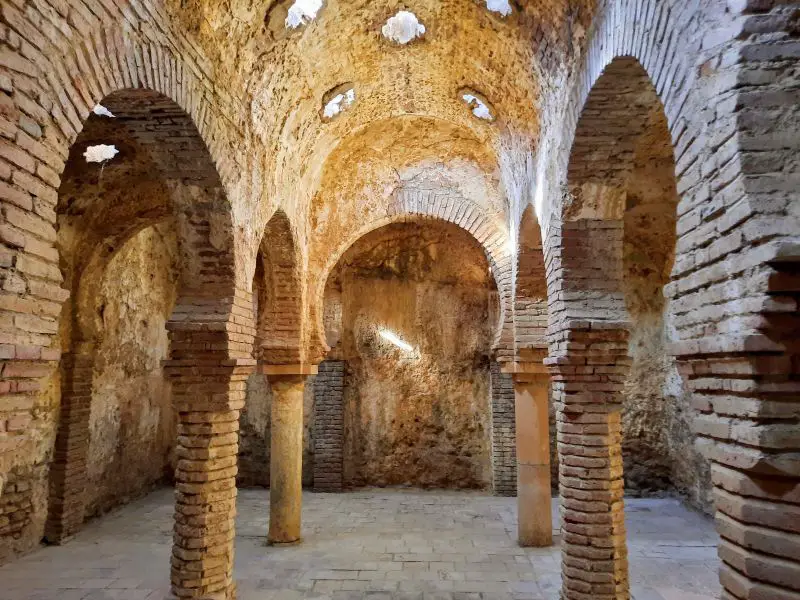
The Arab Baths, built at the end of the 13th century and located in the old Jewish quarter, next to the Guadalevín river and the Culebras stream, are the best-preserved baths of this type in Spain and another of the most beautiful places to visit in Ronda.
Following the example of Roman baths, the enclosure has a cold, warm and hot room, which were used to purify the bodies before entering the Medina and for the social relations of the locals.
The three rooms are now conserved, with the central one featuring several horseshoe arches and beautiful star-shaped skylights, as well as the entire hydraulic system and the water heater. Arab bath is one of the best places to visit in Ronda, Spain.
Visiting hours: Tuesday to Saturday from 10 am to 2 pm and from 3 pm to 6 pm; Sunday and Monday from 10 am to 3 pm.
25. Walls of Ronda
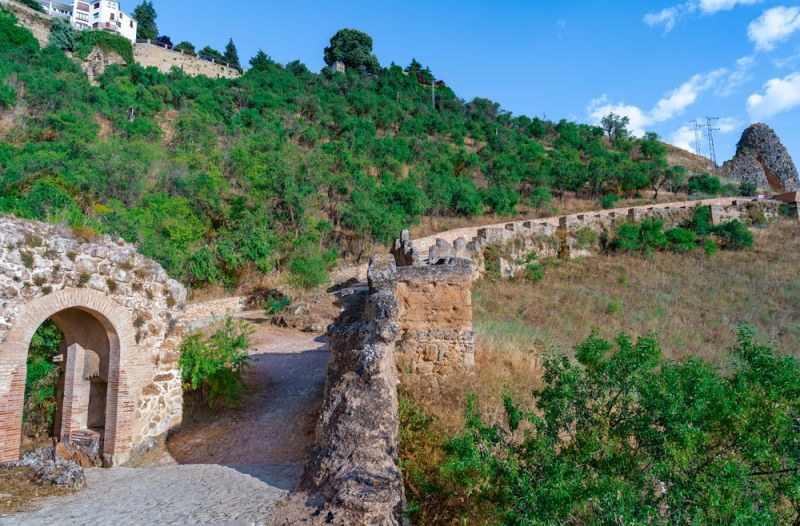
After visiting the Arab baths, you can return to the old town by climbing the stairs before crossing the arch of Felipe V and bordering the ancient walls until you reach the Puerta de Cíjara.
These imposing walls, combined with the gorge and the Guadalevín river, made Ronda impregnable until the arrival of the cannon and one of the most important cities of the Middle Ages.
After seeing the walls up close, you can walk along Armiñán street, passing by the curious Museum of the Bandolero and stopping in front of the Alminar de San Sebastián. Another reminder of the great Arab past of the city.
How to get to Ronda
To get to Ronda, you can land at Malaga airport, located just over an hour’s drive away, or at Seville airport, less than two hours away by car.
If you do not have a car, you can take one of the buses that leave every day from the bus station in Malaga or a train from the Maria Zambrano station.
Where to park in Ronda
We do not recommend driving into the heart of the old town of Ronda, as the streets are narrow and there are hardly any places to park your car.
But there are areas and parking lots close to the center. The largest is the Public Parking La Concepción (location), recommended if you visit Ronda only for a few hours.
Although it is paid, the prices are reasonable. You can walk around the Avenida Andalucía, where there are plenty of free parking places, and also in the surrounding streets such as Calle Sevilla, which is where we left it.
Where to stay in Ronda
If you intend to stay in a nice little hotel, these are good ones:
- Hotel San Francisco (with a lovely terrace).
- Hotel Colón (one of the best rated in Ronda)
- Acinipo (with an unbeatable location)
- Apartamentos Baiti (if you prefer to stay in a very fantastic apartment)
In conclusion, we can say that Ronda is worth a visit. The ancient history that it bears, the monuments that portray the Muslim civilization scenery, and the beautiful places which take back to another time make Ronda, Spain a perfect destination gateway.
So, what do you think? Is Ronda worth visiting for you? Which one of the best places in Ronda you have decided to visit first?
